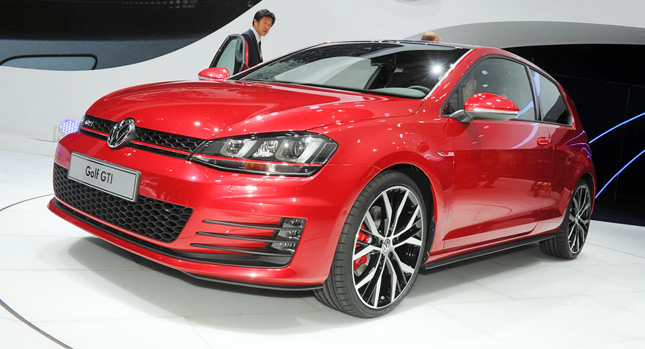Who are we kidding; it may be billed as a concept, but even VW doesn’t make much effort into hiding the fact that the “design study” that made its debut alongside the rest of the seventh-generation Golf models at the 2012 Paris Auto Show is actually the production version of the Mk7 Golf GTI .
The German automaker even released a launch date: the new Golf GTI in both three- and five-door body styles will go on sale in mainland Europe in early 2013 and in the UK next summer (no word yet on when it will arrive in North America).
The new GTI stands out from lesser versions of the Golf thanks to its honeycomb grille (first introduced in the Mk5) with double red-stipe accents, the smoked LED rear lights and license plate illumination, the red brake calipers behind the five-spoke alloy wheels and the 80 mm diameter tailpipes with a chrome finish.
Traditional GTI themes, such as the golf ball-shaped gear lever, the tartan cloth upholstery and the flat-bottomed sports steering wheel confirm that this is a production-ready car.
Like all Mk7 Golfs, the GTI rides on VW’s all-new MQB platform. It gets a variable-ratio steering system, which in theory at least, makes driving easier at low speeds while providing the necessary feedback when the driver is pressing on.
The big news is that the GTI’s new 2.0-liter four-cylinder, direct injection turbocharged engine, not only is more powerful that its predecessor, but it will also be offered in two outputs, with buyers having the choice of two six-speed gearboxes, a standard manual and an optional dual-clutch DSG.
In standard spec, output is 220PS (217HP) and maximum torque 350 Nm (258 lb-ft) – 70 Nm (52 lb-ft) more than the previous model and equal to the Mk6 Golf R. The 0-100 km/h (0-62 mph) sprint takes 6.6 seconds and top speed is 246 km/h (153 mph).
Thanks to VW’s technology, which includes direct injection and a standard auto stop/start system, the manual gearbox-equipped GTI has an average fuel consumption of 6.0 lt/100 km (47.1 mpg Imperial, 39.2 mpg US) and emits 140 g of CO2 per km. Thus, it fulfills not only current emission regulations but also the stricter EU-6 standards that will come into effect in 2014.
For the first time ever, VW offers a factory-prepared “performance pack”. Those expecting huge power gains will be disappointed: output is increased by just 10PS (10HP), the 0-100 km/h (0-62 mph) time drops by a mere 0.1 seconds to 6.5″ and top speed is barely higher at 250 km/h (155 mph).
In fact, the “performance pack” seems like a misnomer; calling it the “handling pack” would probably be more fitting. That’s because, despite the modest increase in performance figures, it also includes a differential lock that reduces power understeer and larger diameter front discs.
PHOTO GALLERY































